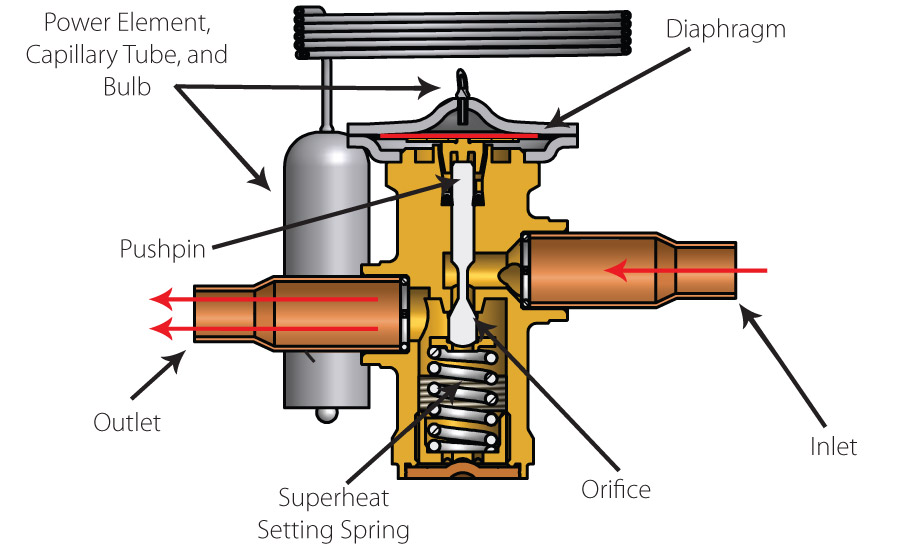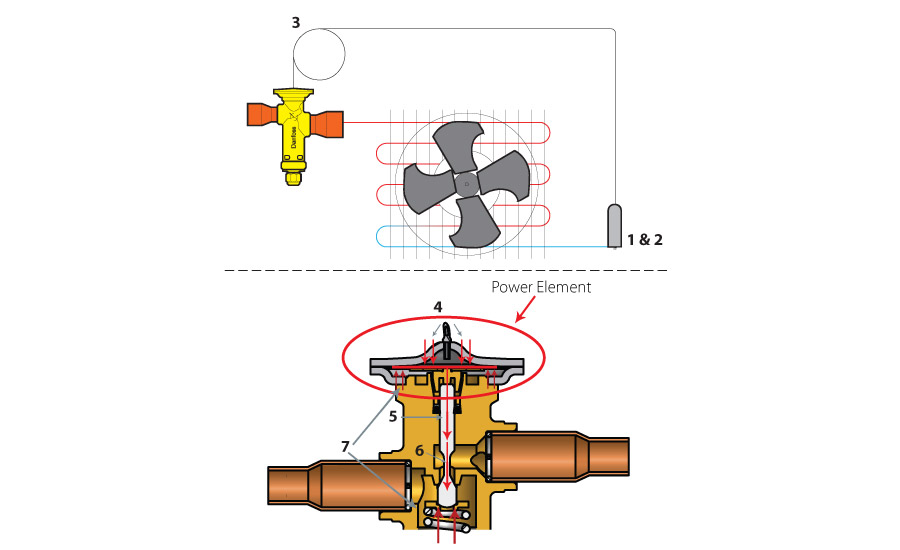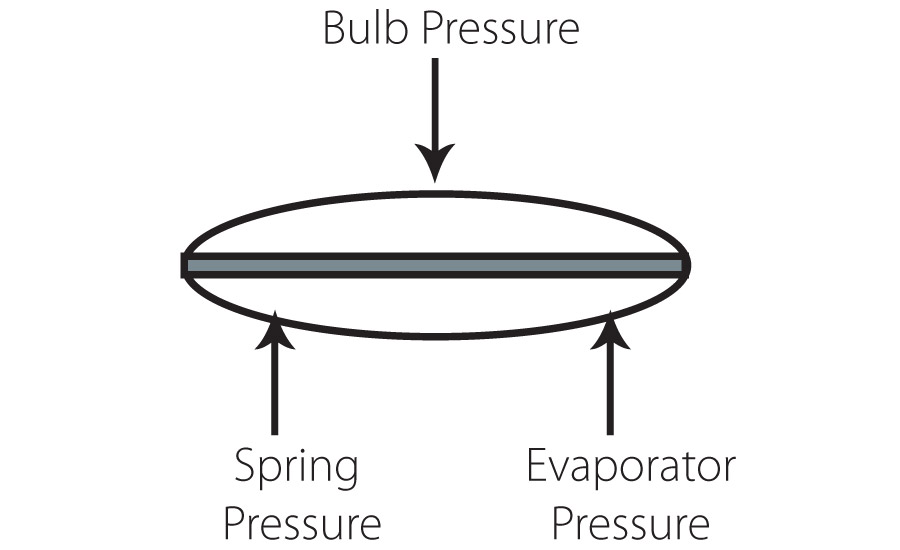The HVAC industry has seen a significant increase in thermostatic expansion valve (TXV) usage in the past decade. In 2006, the U.S. Department of Energy (DOE) set new standards for newly manufactured residential air conditioning systems. Whereas the previous standard had mandated a SEER of 10, the latest standard requires new systems achieve a SEER of 13 or higher. This new requirement has affected systems in various ways. For example, prior to 2006, the majority of residential air conditioning systems used pistons or simple orifice-type metering devices. Currently, the majority of residential air conditioning systems are equipped with a TXV as the metering device.
Even though TXVs are the most popular metering devices for residential air conditioning systems, there is still a lack of knowledge about TXV functionality in the market.
TXV FUNCTIONALITY
Each TXV has three main forces at play:
• Spring Pressure — This constant pressure is set at the factory and determines the superheat at which the valve works. Some spring pressures can be adjusted, but they must be manually changed by the technician.
• Evaporator Pressure — This pressure represents the evaporator load on the system and determines the opening degree of the valve.
• Bulb Pressure — This is what drives the valve open. It’s based on refrigerant temperature changes existing in the evaporator.
Since the spring pressure is constant, the variable forces are the bulb pressure and the evaporator pressure. The valve drives to a set superheat — the opening degree varies depending on the load. Thus, a TXV’s capacity is driven by superheat.
Every year, manufacturers review failed TXVs that have been returned. While conducting the reviews, the first step is to identify the specific problem with each valve and what is happening to the system.
As an example, in one such case, several indoor coils were experiencing problems with ice building up on the evaporator coil during the cooling season. Ice buildup occurs when the saturated suction temperature operates below freezing. Ice buildup shouldn’t happen in residential systems, where the saturated suction temperature should be about 45°F. However, the ice buildup was never observed until the summer, despite the problem likely existing much longer — a result of the peak operating hours being much longer in summer than in the other seasons. For example, during the spring, ice may form during peak hours, but, due to the season’s mild temperatures, the system will naturally defrost and the ice will melt during the off period. In contrast, the system will likely not have an opportunity to defrost during the summer due to the longer run times. Environmental factors like these can lead to a system’s problems going unnoticed until seasonal conditions change. While this is just one example, it illustrates the kinds of problems that can occur even with something as basic as identifying the symptoms of system malfunction.
TROUBLESHOOTING
When it comes to troubleshooting TXV issues, here are some basic things to look out for:
Sensing bulb placement — An improperly mounted sensing bulb can often result in the TXV hunting. Poor sensing bulb mounting includes things like the bulb not being in good contact with the pipe, not being sufficiently insulated, or being located where oil or liquid can influence it. The bulb should be mounted on the evaporator outlet downstream from the refrigerant header, in a position on the pipe least affected by liquid refrigerant and oil, and on the upper surface of the pipe between 2 o’clock and 10 o’clock. The bulb should also be on a straight length of pipe without any brazing seams or irregularities in it. The seams or irregularities will prevent the bulb from maintaining proper contact with the pipe, impacting its ability to react to superheat changes.
System charge — TXV metering devices should be charged according to the system’s subcooling readings, not the superheat. The basic principle is that the condenser subcooling will increase as refrigerant is added, and the condenser subcooling will decrease as refrigerant is removed. To determine the subcooling for a system, use a pressure-temperature chart to convert the measured pressure to the saturation temperature. For example, if the pressure reading of a system using R-410A is 365 psig, the saturation temperature, according to the PT chart, would be 110°F. From that number, the measured temperature leaving the condenser should be subtracted, which, in this example, is 97°. Thus, 110° (R-410A saturation temperature) subtracted by 97° (measured temperature leaving the condenser) equals 13° (subcooling).
The system should always be charged to the manufacturer’s recommendations according to the system’s configuration and the ambient conditions at the time of installation, although the typical recommendation is 10° at the indoor coil just ahead of the valve.
Flash gas — Subcooling can also be thought of as a measurement of the density of the refrigerant. From less than 10° of subcooling, and the closer the system approaches to 0° subcooling, the more likely the system will be in a saturated state where flash gas or bubbles will enter the liquid refrigerant. This is particularly problematic if the flash gas appears in the line not long before the TXV. Each TXV is designed to allow liquid, not gaseous, refrigerant through. R-410A, for example, is eight times as dense as a vapor than as a liquid. That means that flash gas can actually clog a TXV’s nozzle and prevent the injection of liquid refrigerant.
Other causes of flash gas include crushed refrigerant liquid lines, plugged filter driers, and pressure drops due to vertical liquid line installations. Flash gas, whatever the cause, will often make the TXV appear to be malfunctioning despite it being able to operate normally.
Superheat — While many TXVs are able to have their superheat adjusted, this practice should not be employed unless all other possible causes of improper feeding have already been investigated. When the superheat is adjusted, only the smallest changes possible should be made (1/4 to 1/2 turns) and sufficient time allowed for the system to stabilize before measurements are taken and additional adjustments are made.
Additionally, when adjustments are made to the superheat, the system must not be under an unusually high load. During pulldown or defrost, excessive superheat and evaporator pressures and temperatures are normal and are the result of the TXV opening in reaction to the high load.
Understanding how TXVs operate and following essential troubleshooting steps can help technicians save valuable time on the job site and get the system up and running more efficiently.
Publication date: 1/25/2016















